Philadelphia Zoo
The Philadelphia Zoo, located in the Centennial District of Philadelphia, Pennsylvania, on the west bank of the Schuylkill River, was the first true zoo in the United States. Chartered by the Commonwealth of Pennsylvania on March 21, 1859, its opening was delayed by the American Civil War until July 1, 1874. The zoo opened with 1,000 animals and an admission price of 25 cents.[3] For a brief time, the zoo also housed animals brought over from safari on behalf of the Smithsonian Institution, which had not yet built the National Zoo.[4]
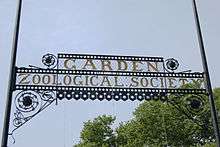 The gate above the zoo's entrance | |
| Slogan | America's First Zoo |
|---|---|
| Date opened | July 1, 1874 |
| Location | Philadelphia, Pennsylvania, US |
| Coordinates | 39°58′28.22″N 75°11′44.44″W |
| Land area | 42 acres (17 ha)[1] |
| No. of animals | ~1,300[1] |
| No. of species | 340+ |
| Annual visitors | 1.2 million[1] |
| Memberships | Association of Zoos and Aquariums[2] |
| Owner | The Zoological Society of Philadelphia |
| Public transit access | |
| Website | Official website |
The Philadelphia Zoo is one of the premier zoos in the world for breeding animals that are difficult to breed in captivity.[5] The zoo is consistently ranked as one of the top zoological destinations in the United States, alongside the San Diego Zoo and ZooTampa at Lowry Park.[6] The zoo also works with many groups around the world to protect the natural habitats of the animals in their care.
The zoo is 42 acres (17 ha) and the home of nearly 1,300 animals,[1] many of which are rare and endangered. Special features include a children's petting zoo, a paddleboat lake, a rainforest themed carousel, a ropes course, and many interactive and educational exhibits.
History
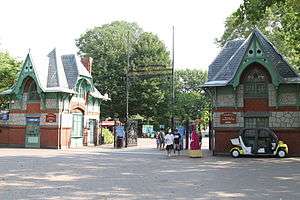
When the Philadelphia Zoological Garden first opened its Victorian gates on July 1, 1874 to over 3,000 visitors, it was the only institution of its kind in the New World. The zoo began with varied exhibits containing 200 mammals including buffalo, deer, wolves, foxes, bears, and monkeys, as well as 67 bird species, and 15 reptiles. Reptiles and small mammals were housed in The Solitude, a mansion built by John Penn in 1785. A carriage house was located at the entrance for horses that had transported visitors to the zoo. The landscaping and architecture mimicked a Victorian garden atmosphere that is still represented in the present zoo grounds.
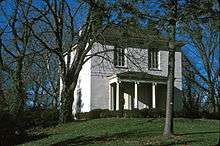
The 1876 Centennial Exposition was held in Fairmount Park, a few blocks from the 33-acre (13 ha) zoo. U.S. President Ulysses S. Grant had officiated at the Exposition and visited the zoo on April 23. Zoo attendance increased to nearly 680,000 visitors in 1876, a 36 percent increase over the preceding year, and set a record that would remain unmatched until nearly 858,000 visited in 1951.
The Penrose Research Laboratory was established in 1901.[7] The first of its kind in any zoo, the Penrose Research Lab contributed to a reduced rate of disease, increased vigor, and longevity among zoo animals. In 1901, the lab began performing necropsies on every zoo animal that became ill and died. The lab's history of preventive medicine reflected the foresight of Dr. Charles B. Penrose and Dr. Cortland Y. White, professors at the Medical School of the University of Pennsylvania.
The zoo received railroad visitors at the Zoological Garden station on 34th Street and Girard Avenue from its opening in 1874 until the station was closed in 1902. Since 2013, zoo officials have been working to get the station restored and reopened, to potentially increase attendance and alleviate parking issues on their busiest days.[8]
Philadelphia Zoo has developed a distinguished breeding program over the years and is credited with many "firsts"[9] including: the first successful birth of an orangutan and a chimpanzee in a U.S. zoo in 1928, the first cheetahs born in a zoo in 1956, the first successful birth of an echidna in North America in 1983, and the first successful birth of a giant river otter in North America in 2004. The first recorded parent-reared Guam kingfisher was bred at the zoo in 1985.
Philadelphia Zoo also pioneered the first captive management of flamingos under the direction of curator emeritus John A. Griswold. Through innovative feeding techniques, the zoo was the first to gain the pink and red pigmentation of these birds. The zoo was the first to successfully breed Chilean and greater flamingos in captivity.[10]
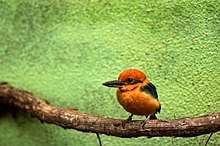
The brown tree snake was introduced to the island of Guam in the 1940s, and as a result, bird species endemic to the island were driven to extinction in the wild by the invasive serpent.[11] In 1983, the Guam Bird Rescue Project was spearheaded by the Philadelphia Zoo in an attempt to save the Guam kingfisher and the Guam rail, two native species still present in large enough numbers to benefit from intervention.[12] The rescue plan called for the capture of all kingfishers and rails on Guam, along with the development of a captive management program. The captive breeding was carried out in U.S. zoos in an effort to save the two species from extinction until reintroduction became feasible.
In the early morning of December 24, 1995, a fire in the World of Primates building killed 23 animals, including a family group of six western lowland gorillas, a family group of three orangutans, four white-handed gibbons, and 10 lemurs (two ruffed lemurs, six ring-tailed lemurs, and two mongoose lemurs).[13][14] All were members of endangered species. The animals died in their sleep from smoke inhalation (carbon monoxide poisoning); none were burned. 10 primates housed in an adjoining building, the Discovery House, survived. At the time of the fire, detection equipment existed in only 20 percent of the zoo buildings; the primates building, which had been constructed in 1985, was not one of them. In the 10 months following the fire, the zoo installed fire detection equipment in all animal buildings.[15]
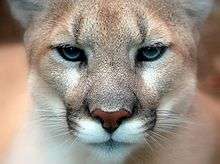
On July 1, 1999, the zoo opened a new primate exhibit featuring 2.5 acres (10,000 m2) of indoor and outdoor areas with 10 species of primates, including Sumatran orangutans, western lowland gorillas, lemurs, langurs, and gibbons.[16] In 2006, the zoo opened a new big cat exhibit showcasing lions, Siberian tigers, Amur leopards, snow leopards, cougars, and jaguars in exhibit spaces reminiscent of their natural habitats. On May 30, 2009, the zoo opened a new aviary featuring two birds that are extinct in the wild: the Guam rail and the Guam kingfisher. In July 2009, the last two elephants, both African bush, were relocated to a sanctuary.
In 2010, a special exhibit called Creatures of Habitat was unveiled featuring 10 animal stations throughout the zoo, with endangered animals represented by more than 30 life-size Lego brick statues. The statues were created by Lego-certified professional artist Sean Kenney.[17]
Philadelphia Zoo opened Treetop Trail in 2011, the first component of its Zoo360 animal exploration trail system. Zoo360 is a network of see-through mesh trails, consisting of elevated and ground-level structures, along which animals can explore the zoo away from their enclosures. Subsequent additions to the system include the Great Ape Trail, Big Cat Crossing, Gorilla Treeway, and Meerkat Maze.[18]
On April 13, 2013, the zoo opened KidZooU on the site of the old Pachyderm House. Also known as the Hamilton Family Children's Zoo and Faris Family Education Center, it is one of the largest projects undertaken by the zoo and replaces the old Children's Zoo open for over 50 years prior. KidZooU is notable for many ecologically conscious features, such as rain gardens and cisterns, geothermal wells, and green roofs, making it the first LEED-certified exhibit at the zoo.[19]
On December 29, 2016, Zenda, the oldest African lion in the U.S. zoo population, was euthanized following a sudden loss of appetite and failing health. Zenda was 25.[20] On February 20, 2018, Coldilocks, a 37-year-old polar bear was euthanized after declining health including potential liver and spinal problems. The average age for a polar bear in the wild is 23 years.[21]
In 2019, the zoo opened WildWorks, a 34 ft (10 m) high ropes course with bridges, ropes, and obstacles. Participants wear climbing harnesses. Two courses are available, each designed for a different age group and skill level. A smaller system for children under 48 in (120 cm) is also available.[22]
Features
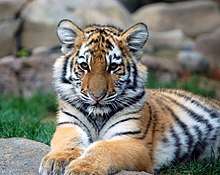
- Zoo360: a first-of-its-kind animal trail system, consisting of five trails—Big Cat Crossing, Gorilla Treeway, Treetop Trail, Great Ape Trail, and Meerkat Maze—which allow the animals to travel along suspended and ground-level mesh structures throughout parts of the zoo.[18]
- The Rare Animal Conservation Center: interactive graphics and up-close views of some of the world's most endangered animals including Rodrigues fruit bats, naked mole-rats, blue-eyed black lemurs, golden lion tamarins,[24] François' langurs,[25] and Bolivian gray titi monkeys.[26]
- Hamilton Family KidZooU & Faris Family Education Center: a children's zoo with indoor and outdoor exhibits of smaller animals that include petting and feeding opportunities, and educational games.[27]
- African Plains: features a southern white rhinoceros, Mhorr gazelles, red river hogs, southern ground hornbills, reticulated giraffes, Burchell's zebras, and hippos.[28]
- McNeil Avian Center: an aviary featuring many species of birds, mainly from Africa and the Pacific Islands, including the hamerkop, the Mariana fruit dove, the metallic starling, and the Victoria crowned pigeon,[29] as well as the extinct-in-the-wild Guam kingfisher[30] and Guam rail,[31] and the critically endangered Bali mynah.[32]
- Bird Valley: features American flamingos, crested screamers, and trumpeter swans.[33]
- Bear Country: features four sloth bears[34] and an Andean bear[35]
- Keybank Big Cat Falls: features numerous species of wild cats including African lions, Siberian tigers, Amur leopards, snow leopards, jaguars, and cougars.[36]
- Small Mammal House: features mammalian species such as pygmy loris, meerkat, pygmy marmoset, harvest mouse, dwarf mongoose, Malagasy giant rat, Hoffmann's two-toed sloth, and vampire bat.[37] An outdoor trail system called Meerkat Maze allows the meerkats to travel through mesh tunnels near visitors.[38]
- Monkey Junction: includes a pair of black-headed spider monkeys a pair of brown spider monkeys.and squirrel monkeys [39]
- Outback Outpost: includes emus and a mob of red kangaroos.[40]
- PECO Primate Reserve: opened in 1999 with primate species including Sumatran orangutans, western lowland gorillas, lar gibbons,, and four types of lemurs—aye-aye, black-and-white ruffed, Coquerel's sifaka, and ring-tailed.[41]
- Penguin Point: opened in June 2018 as a remodel of the former polar bear habitat, now houses 22 Humboldt penguins.[42]
- The Reptile and Amphibian House: features many species of amphibians and reptiles, including giant tortoises, crocodilians, endangered amphibians like the Panamanian golden frog, and the venomous king cobra;[43] also features an outdoor exercise yard for reptiles from June through August,[44] and a special area for the Aldabra and Galápagos tortoises from April through October.[45]
- Water is Life: features a family of rare giant otters (the first successfully bred giant otters in North America),[46] red pandas,[47] a Canada lynx,[48] and a fossa.[49]
- Wings of Asia: an outdoor aviary with an Asian garden where guests may hand-feed Asian birds such as golden pheasants, satyr tragopans, Temminck's tragopans, spotted doves, and white-crested laughingthrushes.[50]
Special behind-the-scenes experiences are offered,[51] as well as overnight stays for scout groups, families, and youth groups.[52] A summer concert series[53] and other events occur annually at the zoo, such as Boo at the Zoo (Halloween),[54] the Summer Ale Festival,[55] and the Global Conservation Gala.[56]
Gallery
References
- "About the Zoo". philadelphiazoo.org. Philadelphia Zoo. Retrieved May 13, 2018.
- "Currently Accredited Zoos and Aquariums". aza.org. AZA. Retrieved July 7, 2012.
- Ashbrook Apartments newsletter, July 2009, Carrboro, North Carolina
- "National Zoological Park, Records". Record Unit 74. Smithsonian Institution Archives. Retrieved 10 April 2012.
- "Philadelphia Tours & Attractions". Archived from the original on 2008-12-05. Retrieved 2008-09-29.
- Maureen, By. "The 10 Best Zoos for Kids: 1. Lowry Park Zoo, Tampa, FL". Parents.com. Retrieved 2008-12-22.
- Federal Writer' Project (Pa.) (September 9, 2010). Philadelphia, A Guide to the Nation's Birthplace. Nabu Press. p. 740. ISBN 978-1171867654.
- "Officials working to restore rail passenger service to Philly Zoo". Archived from the original on April 24, 2013. Retrieved May 16, 2018.
- "Philadelphia Zoo Media Kit".
- Johnson, Alan; Cezilly, Frank (January 1, 2009). The Greater Flamingo. p. 193. ISBN 9781408108970.
- "Invasive Species: Animals - Brown Tree Snake". invasivespeciesinfo.gov. United States Department of Agriculture.
- "Guam Kingfisher". Philadelphia Zoo. Philadelphia Zoo.
- Philadelphia Zoo Fire
- "Fire at the Philadelphia Zoo Kills 23 Primates". New York Times. Associated Press. December 25, 1995. Retrieved February 22, 2017.
- "From the Ashes" (PDF). AZA. Archived from the original (PDF) on 2007-07-03. Retrieved 2007-05-26.
- Gorilla antics anew at Philadelphia's zoo
- Zoo Unveils Exclusive Creatures Of Habitat Lego Brick Animal Exhibit
- "Zoo360 Animal Exploration Trails". philadelphiazoo.org. Philadelphia Zoo. Retrieved May 13, 2018.
- The KidZooU is the Philadelphia Zoo’s first LEED – certified exhibit. http://kidzoou.org/Earth-Friendly-KidZooU.aspx
- "Philadelphia's Zenda, oldest lion in the U.S., dies at 25". Philly.com. December 30, 2016. Archived from the original on December 31, 2016. Retrieved January 3, 2016.
- Izaguirre, Anthony (2018-02-21). "Coldilocks, the oldest captive polar bear in the US, dies". The Boston Globe. Associated Press. Retrieved 2018-02-21.
- "WildWorks ropes course". philadelphiazoo.org. Philadelphia Zoo. Retrieved May 17, 2019.
- "6abc Zooballoon". philadelphiazoo.org. Philadelphia Zoo. Retrieved May 17, 2019.
- "Rare Animal Conservation Center". philadelphiazoo.org. Philadelphia Zoo. Retrieved June 5, 2018.
- "Francois Langur". Philadelphia Zoo. Retrieved September 18, 2019.
- "Bolivian Gray Titi Monkey". Philadelphia Zoo. Retrieved September 18, 2019.
- "About KidZooU". kidzoou.org. Philadelphia Zoo. Retrieved June 5, 2018.
- "African Plains". philadelphiazoo.org. Philadelphia Zoo. Retrieved September 18, 2019.
- "McNeil Avian Center". philadelphiazoo.org. Philadelphia Zoo. Retrieved June 5, 2018.
- "Guam kingfisher". philadelphiazoo.org. Philadelphia Zoo. Retrieved June 5, 2018.
- "Guam rail". philadelphiazoo.org. Philadelphia Zoo. Retrieved June 5, 2018.
- "Bali mynah". philadelphiazoo.org. Philadelphia Zoo. Retrieved June 5, 2018.
- "Bird Valley". philadelphiazoo.org. Philadelphia Zoo. Retrieved June 5, 2018.
- "Sloth Bear". philadelphiazoo.org. Philadelphia Zoo. Retrieved March 3, 2019.
- "Andean Bear". Philadelphia Zoo. Retrieved September 18, 2019.
- "KeyBank Big Cat Falls". philadelphiazoo.org. Philadelphia Zoo. Retrieved June 5, 2018.
- "Small Mammal House". philadelphiazoo.org. Philadelphia Zoo. Retrieved June 5, 2018.
- "Meerkat Maze". philadelphiazoo.org. Philadelphia Zoo. Retrieved June 5, 2018.
- "Monkey Junction". philadelphiazoo.org. Philadelphia Zoo. Retrieved June 5, 2018.
- "Outback Outpost". philadelphiazoo.org. Philadelphia Zoo. Retrieved June 5, 2018.
- "PECO Primate Reserve". philadelphiazoo.org. Philadelphia Zoo. Retrieved June 5, 2018.
- "Penguin Point". Philadelphia Zoo. Retrieved September 18, 2019.
- "Reptile and Amphibian House". philadelphiazoo.org. Philadelphia Zoo. Retrieved June 5, 2018.
- "Reptile Exercise Yard". philadelphiazoo.org. Philadelphia Zoo. Retrieved June 5, 2018.
- "Tortoise Trail". philadelphiazoo.org. Philadelphia Zoo. Retrieved June 5, 2018.
- "Giant otter: In the wild". philadelphiazoo.org. Philadelphia Zoo. Retrieved June 5, 2018. "In March 2004, our female giant otter gave birth at the Philadelphia Zoo, the first North American zoo to have a successful birth."
- "Red panda". philadelphiazoo.org. Philadelphia Zoo. Retrieved June 5, 2018.
- "Canada lynx". philadelphiazoo.org. Philadelphia Zoo. Retrieved June 5, 2018.
- "Fossa". philadelphiazoo.org. Philadelphia Zoo. Retrieved June 5, 2018.
- "Wings of Asia". philadelphiazoo.org. Philadelphia Zoo. Retrieved June 5, 2018.
- "Behind the Scenes". philadelphiazoo.org. Philadelphia Zoo. Retrieved May 13, 2018.
- "Spend the Night at the Zoo". philadelphiazoo.org. Philadelphia Zoo. Retrieved May 13, 2018.
- "Rock 'n' Roar Children's Concerts". philadelphiazoo.org. Philadelphia Zoo. Retrieved May 13, 2018.
- "Boo at the Zoo". philadelphiazoo.org. Philadelphia Zoo. Retrieved May 13, 2018.
- "Summer Ale Festival" Archived 2018-05-14 at the Wayback Machine. philadelphiazooevents.com. Philadelphia Zoo. Retrieved May 13, 2018.
- "2018 Global Conservation Gala". philadelphiazoo.org. Philadelphia Zoo. Retrieved May 13, 2018.
External links
![]()
- Official website
- Aerial photographs at the Historic American Buildings Survey
- Listing and photographs at the Historic American Buildings Survey
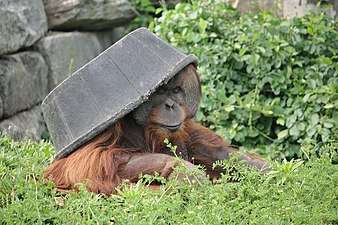
_-Philadelphia_Zoo.jpg)